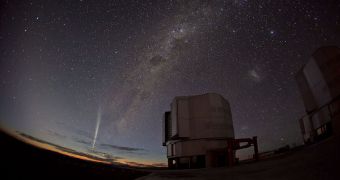Earlier this month, we should have witnessed the destruction of a comet, as it plunged too close to the Sun for it to be able to remain in one piece. However, the object did just that, despite all odds, and became somewhat of a celebrity in the process. This is comet Lovejoy.
Astronomers at the Paranal Observatory, in Chile, decided to track the object as it passed overhead in the night sky. They were able to do so using ground instruments located next to the Very Large Telescope (VLT), and even created a time-lapse video clip of the object's passing.
The reason why everyone was so interested in Lovejoy is that the comet is what experts call a sungrazer, meaning that its path takes it extremely close to the star's surface during their trek through the inner solar system.
Usually, the comets cannot withstand the encounter, since they are made up of loosely-bound rocks and ice. When intense heat from the Sun melts away the ice, the entire nucleus of the comet becomes unstable and disintegrates.
Lovejoy passed within 140,000 kilometers (86,991 miles) of the solar surface, which is extremely close. NASA solar observatories kept track of the object as it was heading towards its apparent doom, and experts were extremely surprised to see it emerge on the other side of the star.
The time-lapse video produced at Paranal was snapped by Gabriel Brammer, who is an astronomer at the European Southern Observatory. ESO manages the Paranal Observatory for a number of European countries.
“On the last morning of my shift I tried to try catch it on camera before sunrise,” Brammer explains. He adds that the VLT Laser Guide Star beam is also apparent in some of the images. This laser is used to point the four mirrors of the telescope in a very precise direction.
“The tail of the comet was easily visible with the naked eye, and the combination of the crescent Moon, comet, Milky Way and the laser guide star was nearly as impressive to the naked eye as it appears in the long-exposure photos,” he goes on to say.
According to astronomers, Lovejoy will visit the inner solar system again in 314 years. It would be interesting to see if scientists in the future are able to observe it. Scientists are currently taking bets as to whether the object will endure another three centuries without falling apart.
Comet Lovejoy from the VLT, Chile from Gabe Brammer on Vimeo.

 14 DAY TRIAL //
14 DAY TRIAL //